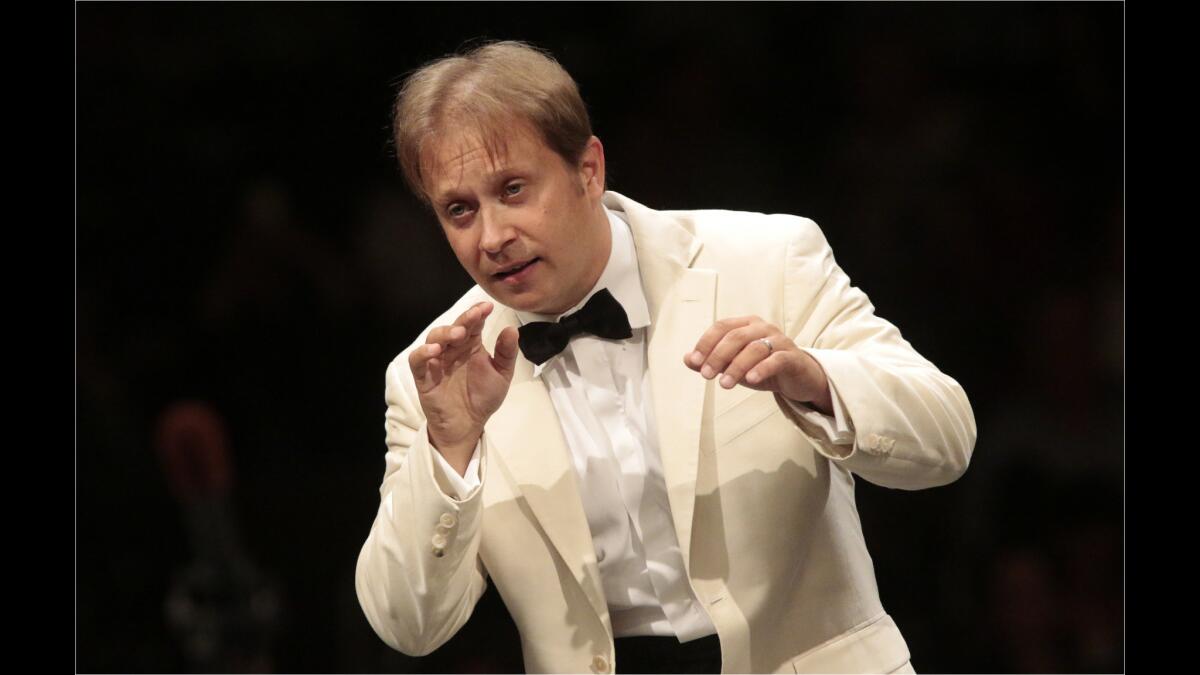Review: Sun shines on Hollywood Bowl guest conductor Ludovic Morlot

In his three seasons as music director of the Seattle Symphony, Ludovic Morlot, the feisty young French conductor who is this week’s Los Angeles Philharmonic guest conductor at the Hollywood Bowl, has done a savvy job in changing his orchestra’s image.
He began his tenure in Seattle with Frank Zappa’s “Dupree’s Paradise,” the first piece on a program that concluded with Beethoven’s “Eroica” Symphony. A performance this June in which Morlot accompanied Seattle rapper Sir Mix-A-Lot became a controversial and viral “classical” video on YouTube.
The world premiere of Elliott Carter’s last orchestral piece, “Instances,” was a Morlot coup for Seattle, as was the premiere of John Luther Adams’ arrestingly immersive “Become Ocean,” which won this year’s Pulitzer Prize in music.
The hourlong “Become Ocean” at the Bowl might have been an event, a musical way of letting a lethargic Labor Day beach day linger. But the L.A. Phil these days leaves exploration, aquatic or otherwise, for indoors, at Walt Disney Concert Hall. That meant no Zappa for his Bowl debut (he conducted the L.A. Phil at Disney last winter), even if “Dupree’s Paradise” happens to be perfect, perky summer music.
Tuesday night, Morlot did, at least, become sunshine, with bits of Mendelssohn’s merry “A Midsummer Night’s Dream” and the composer’s cheerful “Italian” Symphony framing Mozart’s sublime Clarinet Concerto. A summer’s day was, indeed, sensed in performances that were engagingly bright when feisty and engagingly sluggish (a nap by the water?) when not.
The one surprise was in Mozart’s Clarinet Concerto. Finnish clarinetist Kari Kriikku, who is best known as a superb specialist in contemporary music, showed up not with a modern clarinet as expected (and announced in the program), but a basset clarinet. He was within his historic rights since that is the instrument, which resembles a modern A clarinet with an extension and slightly curved mouthpiece, for which Mozart composed his concerto.
The basset clarinet’s tone is more acidic and thinner than that of the creamy modern clarinet. Kriikku, who played seated, is a more scholarly, recondite player. He can be playful, but he doesn’t push it. He seemed delighted, instead, with the basset clarinet’s edgy tonal character, its ability to enhance dissonance. He found hints of dark corners in Mozart’s most fluidly lyrical concerto where others would not think to look.
Kriikku contributed a short cadenza of his own in the first movement that gave the game away. He shocked Mozart’s eloquent melodies with sudden spikes, the aural effect of taking a match to the original score.
The slow movement was tranquil on the surface but not smooth, giving the impression of lyricism covering up for something. The Finale was fast, fun and matter-of-fact, as if to say it is best to live for now because you never know.
Morlot was a genial accompanist, perky in the outer movements, placid in the Adagio, but not really on his soloist’s more curious and challenging wavelength. Modern music may suit Kriikku better than Mozart, but this was fascinating.
In Mendelssohn, Morlot made fast music sparkle. With the first and last movements of the “Italian,” Mendelssohn’s Fourth Symphony, he produced sparks, not the atmospheric kind you might create by lighting a match but from cutting a wire and emitting a shock.
Morlot frequently asks for bursts of bright color, and in that he excels. But the L.A. Phil — the ensemble kept small in all the works — never sounded quite at ease. For the Andante movement in the symphony and the Nocturne in “A Midsummer Night’s Dream,” the electricity was low; the colors, dimmer; the tension, lax.
Thursday night, Morlot returns for Ravel, Barber and Copland, American and French music of the 20th century that seems to suit him best. He has made four recordings with the Seattle Symphony, all French and American repertory. His recording of “Become Ocean” becomes available Sept. 30 and is one of the most anticipated of the fall releases.
More to Read
The biggest entertainment stories
Get our big stories about Hollywood, film, television, music, arts, culture and more right in your inbox as soon as they publish.
You may occasionally receive promotional content from the Los Angeles Times.











